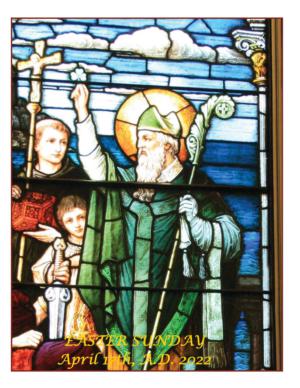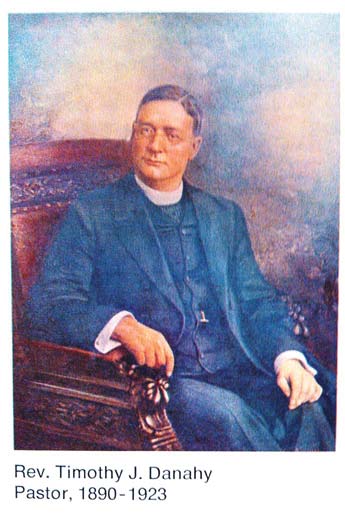Easter Greetings

The front cover of our Easter Sunday Bulletin shows the Saint Patrick window of our parish church. The historic scene depicted is Easter Sunday, March 26th, A.D. 433, when Bishop Patrick, the Missionary Christi. Apostle to the Irish, first preaches the Gospel to the High King of Ireland at Tara. On this occasion he used the three-leaf shamrock to try to convey an idea of the mystery of the Trinity-inUnity of God. (PHOTO by Paul Eldridge.) We now begin the Great Day of Easter which will go on for the next Fifty Days to Pentecost, and reverberates all the way to the Feast of Corpus May all the adversities of life give place to the great weight of glory which is the hope we have in our Risen Lord Jesus Christ! Christ is Risen! Alleluia! Indeed He is Risen! Alleluia!
PARISH LENTEN MISSION for A.D. 2022 CONFERENCE VI: A MARIAN “GOLDEN AGE”
(Given at the VIA CRUCIS, April 8th, 2022)
The title of this our final Conference tonight is: A Marian ‘Golden Age’. Both the Lourdes of the Apparitions to Bernadette in 1858, and the development of the “Lourdes of Pilgrimage” after 1872 occurred within a period of the Church’s life which we may characterize as a Marian “Golden Age”, a Golden Age of Mary, where popular devotion to Our Lady among the Catholic faithful and theological interest in further “plumbing the depths” of Mary’s rôle in the economy of salvation converged in some very beautiful, and light-some, and emotionfilled ways.
We might set the markers of this Golden Age as the two Solemn Dogmatic Definitions around Mary. The first: the Definition of the Immaculate Conception of Mary in1854, and the second: the Definition of the Assumption of Mary into Heaven in 1950. The Assumptionist Fathers who inspired and led the National Pilgrimage of France to Lourdes each summer to coincide with the Octave of Mary’s Assumption, August 15th - 22nd, prayed, among their intentions, for a Solemn Definition of Mary’s Assumption as Pius IX had done for the Immaculate Conception. In this, their prayerrequest was exactly fulfilled!
By another reckoning, we might broaden our Marian Golden Age to begin with its prelude in the Apparitions of the Blessed Virgin Mary to St. Catherine Labouré at the Rue de Bac in Paris, 1830, and then end it with a coda in Pope Paul VI’s Proclamation of Mary as “Mother of the Church” at the conclusion of the Second Ecumenical Council of the Vatican in 1965.
What followed upon the close of Vatican II, however, was a sharp anti-Marian reaction from within the Church herself, resulting in such things as the diminishment of Marian feasts in the Liturgy and even, in some particular cases their elimination, the setting up of opposition between the “Renewal” of the Church and the Prayer of the Rosary, Fatima devotions, May Processions and all things Marian.
The very things which had heretofore been greatly honored in the Catholic Church were now considered suspect of “Mariolatry” (i.e., a false, exaggerated worship of Mary in place of the honors due to God). This period, as we know, was the cause of a great deal of pain and confusion among Catholic people.
This anti-Marian reaction has abated somewhat within the Church—there has been a corrective of this post-Vatican II “corrective”—but it does, nonetheless, mark a breach between us and this previous Golden Age of Mary, which the mass gatherings of the Assumptionists’ National Pilgrimage to Lourdes in the 1870s, 80s, and 90s epitomized so well.
What conclusions then can we make from our consideration of the “Lourdes of Pilgrimage” over these past Lenten Fridays? I would suggest three.
The first conclusion is a deeper understanding of how God answers prayer. The National Pilgrimage to Lourdes began as a prayer-request mobilization of loyal French Catholics. In the course of events the chief prayer intentions such as the Restoration of the Bourbon Monarchy, the Recovery of the Pope’s temporal powers, the transformation of France into an unabashedly Catholic Christian Commonwealth did not receive a favorable answer from God.
On the other hand, other prayer intentions were favorably answered, such as the prayer for the Solemn Definition of the Dogma of Mary’s Assumption. And looking at the miracles, the growth of the popularity of Lourdes world-wide, the realization of so many acts of charity–who would dare to say that God did not give unction to the prayers of the pilgrims at Lourdes?
Looking at this from our vantage point, we can see that the more time-bound and in-thismoment specific the prayer-petition was–such as the Restoration of the Bourbon Monarchy and the Coronation of Henry V–the less likely it was to be fulfilled, whereas the more openended and the more spiritual value contained in a prayer-petition, the more God outdid Himself in generosity. This is a lesson we can all apply in how we formulate our own prayer-requests to God.
The second conclusion: The Lourdes of Pilgrimage and the unbelieving world’s reaction to it offer a template for understanding the world we presently live in. In this world Science and Reason are set up as the polar opposite to Religion and Faith. In this world Religion and Faith are always on the defensive. Science and Reason, divorced from all religion, have the cultural upper hand. It is the world Pope Paul VI spoke of at the end of the Vatican II, 1965, where “the religion of the God-made-Man has met the religion of the man who makes himself God.”
It was during the latter decades of the 1800s, precisely during the decades when the Pilgrimage to Lourdes was such a phenomenon, that this modern-day mass unbelief we are so familiar with emerges into history. Therefore, we shouldn’t be dismayed by the reality. It is our destiny to live in these times. We should instead always be learning how to maneuver as Catholic Christian believers in this reality in order to build up our “spiritual immune system”.
And now the third and final conclusion. Our Marian Golden Age, of which the “Lourdes of Pilgrimage” was a part, has ended as an historical time-period. It lasted a long-time, between 96-135 years, but it has receded. Nevertheless, all times and seasons are Christ’s and Mary has no other office but to draw men closer to Christ. And when there has been a particular surge of divine manifestation in a given era, it is not just meant for the people of that time. It becomes a treasure-trove of spiritual riches for those who will be living after that era (which means us).
Thus this Marian Golden Age of yore continues to speak to us and inspire us as a living memory, a living force. It is the extension of Our Lady’s Magnificat onto the plane of time and space. It is a foretaste of heaven on earth. And the Lourdes of Pilgrimage, which still goes on, is a gateway to divine grace.
Father Higgins
Father Timothy J. Danahy (T. J. Danahy) was already the Pastor of St. Mary’s Parish in Newton/ Needham when he made a pilgrimage to Lourdes in the early 1890s. He received a miraculous cure of his damaged eyesight after bathing in the pool of the Lourdes spring. He then made a vow that he would one day build a church in honor of Our Lady of Lourdes, as an offering of thanksgiving. He fulfilled that vow when this church of Mary Immaculate of Lourdes was dedicated on Thanksgiving Day, November 24th, A.D. 1910. This church in which we are worshipping today is a votive offering of a miraculé of Lourdes.

